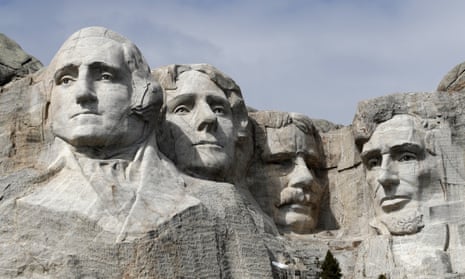Donald Trump’s plans to kick off Independence Day with a showy display at Mount Rushmore are drawing sharp criticism from Native Americans who view the monument as a desecration of land violently stolen from them and used to pay homage to leaders hostile to native people.
Several groups led by Native American activists are planning protests for Trump’s 3 July visit, part of Trump’s “comeback” campaign for a nation reeling from sickness, unemployment and, recently, social unrest.
The event is slated to include fighter jets thundering over the 79-year-old stone monument in South Dakota’s Black Hills and the first fireworks display at the site since 2009.
But it comes amid a national reckoning over racism and a reconsideration of the symbolism of monuments around the globe. Many Native American activists say the Rushmore memorial is as reprehensible as the many Confederate monuments being toppled around the nation.
“Mount Rushmore is a symbol of white supremacy, of structural racism that’s still alive and well in society today,” said Nick Tilsen, a member of the Oglala Lakota tribe and the president of a local activist organization called NDN Collective.
“It’s an injustice to actively steal indigenous people’s land then carve the white faces of the conquerors who committed genocide.”
While some activists, like Tilsen, want to see the monument removed altogether and the Black Hills region returned to the Lakota, others have called for a share in the economic benefits from the region and the tourists it attracts.
Trump has long shown a fascination with Mount Rushmore. South Dakota’s governor, Kristi Noem, said in 2018 that he had once told her straight-faced it was his dream to have his face carved into the monument.
He later joked at a campaign rally about getting enshrined alongside George Washington, Thomas Jefferson, Teddy Roosevelt and Abraham Lincoln. And while it was Noem, a Republican, who pushed for a return of the fireworks on the eve of Independence Day, Trump joined the effort and committed to visiting South Dakota for the celebration.
The four faces, carved into the mountain with dynamite and drills, are known as the “shrine to democracy”. The presidents were chosen by sculptor Gutzon Borglum for their leadership during four phases of American development: Washington led the birth of the nation; Jefferson sparked its westward expansion; Lincoln preserved the union and emancipated slaves; Roosevelt championed industrial innovation.
And yet, for many Native American people, including the Lakota, Cheyenne, Omaha, Arapaho, Kiowa and Kiowa-Apache, the monument is a desecration to the Black Hills, which they consider sacred. Lakota people know the area as Paha Sapa – “the heart of everything that is”.
There are also warnings that a large event at Mount Rushmore will also spread coronavirus – and that fireworks could spark wildfires in the wooded hills there, a huge tourist area where wildlife including buffalo and pronghorn antelope flourish in the region.
The National Park Service stopped staging pyrotechnics at Mount Rushmore in 2010 out of concern that it could ignite wildfires under drought conditions, the Washington Post reports. The memorial is surrounded by 1,200 acres of forested lands, including ponderosa pines, and lies next to the Black Hills national forest’s Black Elk Wilderness.
A multi-state effort was focused on Thursday on fighting a wildfire that started in nearby Custer state park on Wednesday, burning about six miles from Mount Rushmore, the Rapid City Journal reported.
Washington and Jefferson both held slaves. Lincoln, though he led the abolition of slavery, also approved the hanging of 38 Dakota men in Minnesota after a violent conflict with white settlers there. Roosevelt is reported to have said: “I don’t go so far as to think that the only good Indians are dead Indians, but I believe nine out of every 10 are.”
The monument has long been a “Rorschach test”, said John Taliaferro, author of Great White Fathers, a history of the monument. “All sorts of people can go there and see it in different ways.”
The monument often starts conversations on the paradox of American democracy – that a republic that promoted the ideals of freedom, determination and innovation also enslaved people and drove others from their land, he said.
The monument was conceived in the 1920s as a tourist draw for the new fad in vacationing called the road trip.
South Dakota historian Doane Robinson recruited Borglum, one of the pre-eminent sculptors at the time, to abandon his work creating the Stone Mountain Confederate Memorial in Georgia, which was to feature Robert E Lee, Jefferson Davis and Stonewall Jackson.
Borglum was a member of the Ku Klux Klan, according to Mount Rushmore historian and writer Tom Griffith. Borglum joined the Klan to raise money for the Confederate memorial, and Griffith argues his allegiance was more practical than ideological. He left that project and instead spent years in South Dakota completing Mount Rushmore.
Native American activists have long staged protests at the site to raise awareness among the history of the Black Hills, which were taken from them despite treaties with the United States protecting the land. Fifty years ago this summer a group of activists associated with an organization called United Native Americans climbed to the top of the monument and occupied it.
